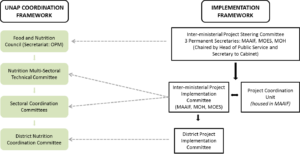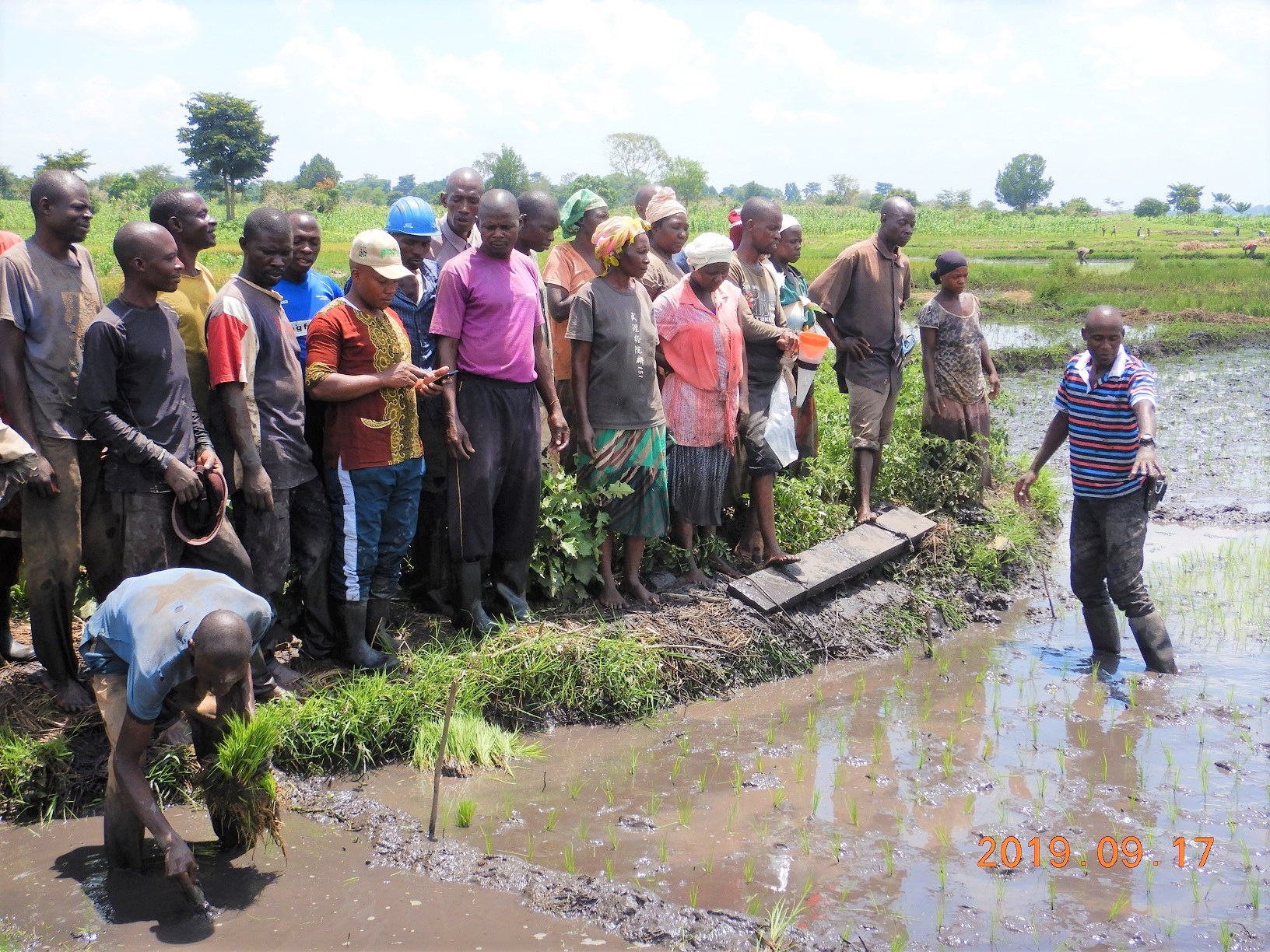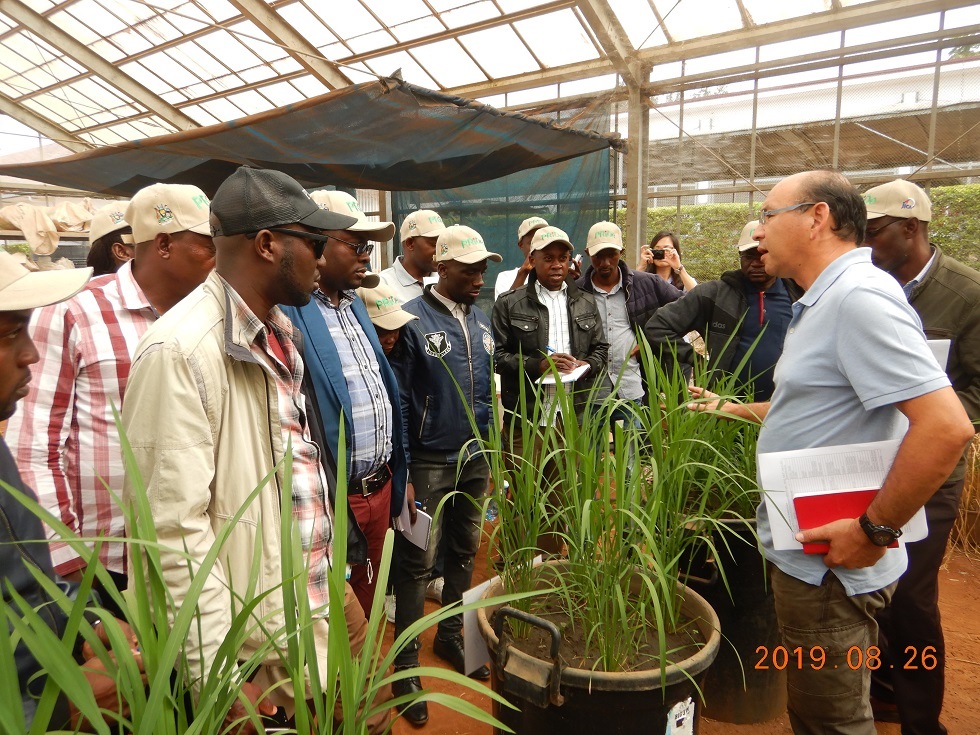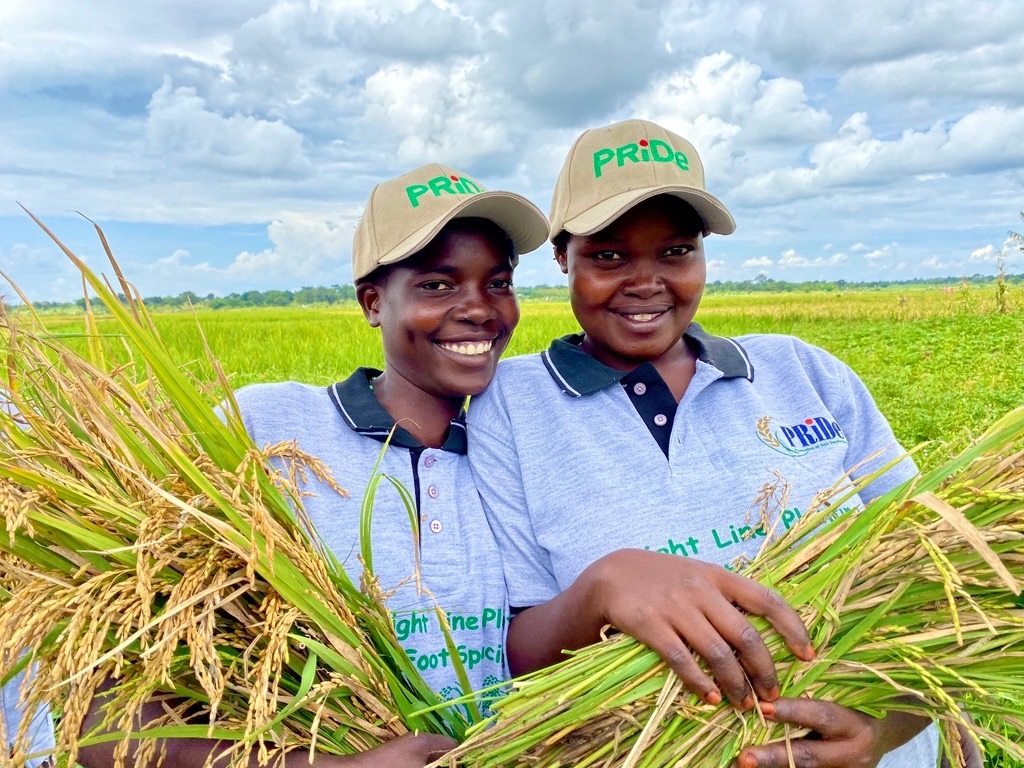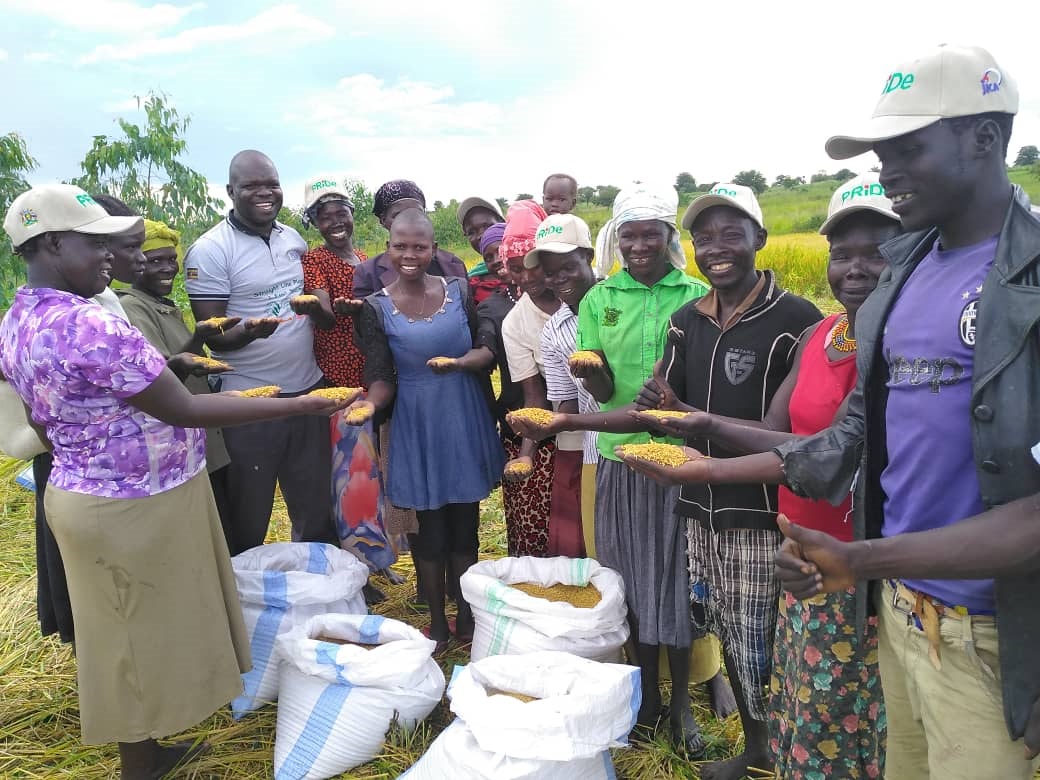The Uganda Multi-Sectoral Food Security and Nutrition project (UMFSNP)
Project Background
The Uganda Multi-sectoral Food Security and Nutrition Project (UMFSNP) is implemented, over a period of five years, by the Government of Uganda (GoU) through the Ministry of Agriculture, Animal Industry, and Fisheries (MAAIF) working in a multi-sectoral collaboration with the Ministry of Health (MoH) and the Ministry of Education and Sports (MoES). MAAIF is the lead implementer of the Project and working in close collaboration with MoES, MoH, and selected District Local Governments (DLGs).
The Office of the Prime Minister (OPM) provides general oversight functions and guidance to the Project, in line with its mandate in the Uganda National Action Plan (UNAP).
The funding for the project is in the form of a US$ 27.64 million Grant from the Global Agriculture and Food Security Program (GAFSP) with the World Bank as the Supervising Entity (SE).
Project Development Objective (PDO)
The PDO is to ‘increase production and consumption of micronutrient-rich foods and utilization of community-based nutrition services in smallholder households in project areas.’
The project focus is on promoting short-term changes in high-impact nutrition behaviours and practices that are known to contribute to stunting reduction in the medium- and long-term.
The project complements other agricultural efforts (such as the ACDP), which are designed to raise agricultural productivity and income, but will not address the gap in production and consumption of micronutrient-rich foods, thereby reducing stunting.
Project Beneficiaries
The project supports activities in rural districts of Uganda. The primary beneficiaries are:
(a) Pregnant and lactating women and children under two (2) years in all participating districts delivering enhanced community-based nutrition services.
(b) All household members of Lead Farmers (LFs) and Parents Groups (PGs) participating in nutrition promoting activities with catchment areas of selected primary schools.
In total, the project directly benefits about 1.14 million primary beneficiaries, expected to be mainly from smallholder farming families. Secondary beneficiaries which include primary school teachers and school children; VHTs; agriculture, education, and health line ministry extension workers (at central, district, and sub county levels); and District Nutrition Coordinating Committees.
Table 1: Estimated number of primary project beneficiaries
| Phase | No. Districts | Primary Beneficiaries | Participating Districts | Participating Primary School Communities | |
| Pregnant and lactating women | Children 0-23 months | People in Households of LFs and PGs | |||
| 1 | 5 | 380,000 | 75,000 | 125,000 | 180,000 |
| 2 | 10 | 760,000 | 150,000 | 250,000 | 360,000 |
| 15 | 1,140,000 | 225,000 | 375,000 | 540,000 | |
The selection of project districts was based on regional rankings of 2011 Demographic and Health Survey (DHS) estimates of:
- The prevalence of stunting in under-five children.
- Low dietary diversity, selected because they indicate both the severity of the problem and potential to benefit from the focus on increasing production and consumption of micronutrient rich foods.
Further, the project was designed to mitigate the potentially negative effects of increased agriculture commercialization on nutrition in areas covered by the ACDP project that focuses on staple crops and commodities and will not address homestead production of micronutrient-rich crops, which is essential to food security and nutrition.
The 42 districts in the ACDP were ranked by stunting and dietary diversity. Fifteen districts with a combined score of these two criteria below 10 were identified as having both high under nutrition and high need for interventions to improve dietary diversity.
These 15 districts were from four geographical regions, namely Southwest, West Nile, East Central, and Western. Five of these districts were selected to participate in the project for the first phase (see Table 2) based on readiness for implementation, using the most recent available Ministry of Local Government (MOLG) reports, While most districts met the minimum standards, selection gave weight to the ratings that reflect performance criteria and staff functional capacity, including procurement capacity and performance, council executive performance, and functionality of the district agriculture, education, and health Directorates.
Table 2: Phase 1 and 2 district selection (based on high stunting and low dietary diversity)
| Phase 1 | Five selected districts: Bushenyi, Nebbi, Ntungamo, Maracha and Namutumba. |
| Phase 2 | Ten additional districts were selected in Year 2 on the basis of combined high stunting and low diet diversity: Isingiro, Yumbe, Arua, Bugiri, Iganga, Kiryandongo, Kyenjojo, Kabarole, Kabale and Kasese. The selection process used available MOLG reports on the Local Government readiness for implementation and exclude districts under ATAAS or ACDP with substantial outstanding fiduciary issues |
PDO Level Results Indicators
Progress toward the PDO achievement is measured through the following outcome indicators, all within participating project areas:
- Net change in percentage of households reporting year-round production of at least three micro-nutrient rich crops;
- Net change in percentage of children 6-23 months in households consuming minimum dietary diversity.
- Net change in percentage of women participating in community-based nutrition activities.
PROJECT DESCRIPTION
Project Components
The project supports GoU efforts to improve child nutrition through nutrition interventions across multiple sectors at national and district levels yet to implement selected interventions within each respective sector emphasizing existing systems, budgets, and accountability structures in eligible districts.
The project supports interventions to improve the content and coverage of nutrition services at primary schools and surrounding communities. The focus is on delivering interventions to address the key determinants of chronic malnutrition in project areas, as identified in each sector under UNAP.
These interventions are mainly focused on production and consumption of diversified micronutrient rich crops, nutrition care practices, and hygiene and sanitation demonstration.
Simultaneously, the project supports demand-side approaches to enhance utilization of VHT delivered community-based nutrition services. Primary schools are mandated to establish school gardens as “agriculture and nutrition classrooms” (e.g. for demonstration purposes and to deliver nutrition curricula) although these mandates are often neglected.
Schools are used as an entry point to strengthen linkages between communities and line ministries, specifically MOES (primary school teachers), MAAIF (agriculture extension services), and MOH (health workers and VHTs).
The interventions under Component 1 are delivered in selected primary schools that meet eligibility requirements and their surrounding communities. The activities under this component are largely facilitated by a School Nutrition Committee, a sub-committee of the School Management Committee (SMC), which develops and implements a Primary School Nutrition Action Plan (PSNAP).
The institutional capacities of MAAIF, MOES, and MOH, as well as of participating districts, are supported under Component 2 to enhance coordination, project management, and technical capacity to deliver activities under this project.
Component 3 supports project management and coordination, monitoring and evaluation, and knowledge generation, management and dissemination.
COMPONENT 1: DELIVERY OF MULTI-SECTORAL NUTRITION SERVICES AT PRIMARY SCHOOL AND COMMUNITY LEVELS
The objective of this component is to improve the nutrition functions of;
- Community based institutions;
- Primary schools;
- Agriculture extension mechanisms; and
- VHTs in line with UNAP and the three sectoral strategic plans.
The activities supported are organized broadly by the lead responsible sector, although there is overlap in activities given the cross-cutting nature of interventions and the differing roles and capacities of each sector.
It is estimated that approximately 15 districts, 5,400 VHT members, 1,500 primary school demonstration gardens, 3,000 LFs and 3,000 PGs (consisting of an estimated 45,000 parents), supported over the life of the project.
Sub-component 1.1 Community sensitization and establishment /strengthening of community based institutions (Lead entity: Districts)
This sub-component supports community sensitization and mobilization on nutrition. Activities financed under this sub-component will include:
- Initial sensitization of communities, including media communications;
- Formation, mobilization, and facilitation of PGs from the communities surrounding selected primary schools, each is led by a chairperson who is identified by the PG.
- Two LFs from each primary school catchment area are chosen by the community taking into consideration their agricultural skills, available land, and interest in sharing improved technologies.
Sub-component 1.2 Enhancing nutrition services delivered through primary schools, lead farmers and parent groups (Lead sector: Education)
This sub-component supports the establishment or strengthening of school and community-based nutrition activities, some of which are implemented by the Primary Schools in collaboration with LFs and PGs established under sub-component 1.1, while others are implemented by the teachers and school leadership:
- Establishment/strengthening a “School Nutrition Committee" to develop and implement the PSNAP, including establishing/strengthening demonstration gardens and oversight, with participation of PGs;
- Provision of support for the LFs to establish community-based multiplication and distribution mechanisms to increase community access to improved seeds and vines
- Nutrition education, (food preparation, food safety, and hygiene practices)
- School-based deworming for all school children and weekly iron folic acid (IFA) tablet supplementation for female students in primary four and above (these inputs to be procured by the MOH under subcomponent 1.4).
Prototype Primary School Demonstration Gardens
Each primary school receives a package in Years 1, 2, and 3 to establish/strengthen their school gardens to produce year-round micronutrient-rich crops, and to support nutrition education activities.
The Primary School Demonstration Gardens are primarily managed by the PGs.
Demand for nutritious foods is generated through communications and promotion strategies. The primary incentive for PG participation is to gain skills to increase availability and yields of nutritious foods for home consumption, particularly during hungry seasons, arising from improved soil management and cultivation practices, diversified crops, labour-saving technologies, and improve post-harvesting processes.
Eligible expenses for schools include rainwater harvesting; cooking pots and utensils; gardening tools (e.g. Sprayer Pump, Hoe, Rake, Watering can, Panga, Slasher, Wheelbarrow); locally available and non-locally available micronutrient-rich crop seeds and planting materials; fencing materials; fertilizer; and herbicide/pesticides.
The School Nutrition Committee selects from a menu of nutrition education demonstrations, and the package supports local purchase of necessary materials.
School gardens receive two further years of successively reduced support: Year 2 packages includes locally available and not locally available planting materials and seeds for micronutrient rich crops; fertilizer; and support for nutrition education demonstrations. Year 3 packages includes only support for nutrition education demonstrations. The packages are estimated to cost up to US$10,000 over 3 years
Prototype Lead Farmer Support
Each LF receives a package in Years 1 and 2 to enable community-based multiplication, replication, and adoption of improved agricultural technologies and practices to support year round production of micronutrient-rich foods.
The main incentive for these LFs is improved availability and yields of nutritious foods for home consumption, particularly during hungry seasons, arising from improved soil management and cultivation practices and diversified crops.
The importance of nutritious foods for health and development which is promoted through community nutrition activities.
Year 1 support includes tools (e.g. Sprayer Pump, Hoe, Rake, Watering can, Panga, Slasher); locally available micronutrient rich fruit and vegetable seeds and fertilizer. In Year 2, support includes locally available micronutrient-rich fruit and vegetable seeds as well as introduce non - locally available micronutrient-rich fruit and vegetable seeds and planting materials.
Appropriate varieties were selected following MAAIF and District consultations and with consideration of local food preferences and agro-ecological zone and growing conditions.
Communications and promotion strategies generated from demand for these previously unavailable improved planting materials. LFs are trained to produce and sell nutritious crop planting materials to surrounding households, generating marginal profits expected to provide additional incentive for LF participation.
The LF packages are estimated to cost up to US$1,000 over two years of support.
Sub-component 1.3 Agriculture support for school-based nutrition services (Lead Sector: Agriculture)
This sub-component supports strengthened linkages between agriculture extension services and participating primary school demonstration gardens, specifically
- engagement of MAAIF agriculture crop extension specialists with selected primary schools in development of the PSNAP, agricultural demonstration garden design, and procurement support for the project financed primary school-based activities;
- Technical and procurement support to LFs and communities in expanding production of promoted crops;
- Delivery of a pre-developed nutrition curriculum based on the UNAP priorities.
Sub-Component 1.4 Strengthened nutrition services through Village Health Teams (VHTs) (Lead Sector: Health)
The VHTs were established by MOH to mobilize communities for health and nutrition programs and strengthen delivery of basic health and nutrition services at household level.
This sub-component supports priority nutrition services through VHTs under this mandate. In all selected districts, the project supports the following:
- Community mobilization on nutrition, nutrition behaviour change communications, and monthly growth monitoring and promotion (GMP) of children under 23 months.
- Provision of IFA supplements and deworming for pregnant/lactating women and zinc supplements for children 6-59 months.
In selected primary school catchment areas, the project also supports the following, in line with the MOH mandate to support school health and nutrition activities:
- School Nutrition Committee membership in selected primary schools for development and implementation of the PSNAP;
- Primary school-based nutrition education sessions for students and PG demonstrations, as included in the PSNAP (necessary inputs to be procured by the School Nutrition Committee);
- Deworming tablets for school children and IFA supplements for girls in grade 4 and above.
COMPONENT 2: STRENGTHENING CAPACITY TO DELIVER NUTRITION INTERVENTIONS
This component improves capacity of sectoral institutions to deliver nutrition interventions relevant to this project, including support for:
- National, district, and sub-county, stakeholder sensitization on nutrition and project activities;
- Consultancy services to develop necessary training materials for extension agents, primary schools, and community workers, including workshops to finalize training and support materials and printing and distribution of necessary support materials for each sector;
- Consultant services to deliver nutrition training for relevant district, primary school and community personnel;
- Sector-specific refresher training and supportive supervision for relevant staff at district level and below.
COMPONENT 3: PROJECT MANAGEMENT, MONITORING, EVALUATION AND KNOWLEDGE GENERATION
This component includes initiatives to:
- Ensure project management and coordination;
- Support monitoring, evaluation at all levels, knowledge generation and management, and dissemination of findings within Uganda and globally.
This component finances goods, services, and specified incremental operating costs (for all components).
Sub-component 3.1 Project management and coordination
This sub-component supports:
- Project-related implementation capacity, including support for the designated project coordinator and key additional staff needed in areas such as fiduciary and M&E specialists who make up the Project Coordination Unit (housed within MAAIF);
- Additional activities and related expenditures for central ministries not currently readily handled by their procurement and financial management systems, including management information systems, as well as auditing, and reporting;
- Strengthening district and sub entities fiduciary management and service delivery contracting capabilities, including staff training, as well as supplemental operational funds to carry out explicit project-related mandates.
Sub-component 3.2 Project monitoring, evaluation, and knowledge generation
This sub-component support:
- cross-coordination of project activities;
- The development and implementation of a consolidated project system for regular project activity and fiduciary monitoring reporting.
This is administered by the PCU but requires the three implementing sectors and participating Districts to adopt the system and provide regular reports consistent with it;
- Surveys to provide baseline, midline and end line values, and an impact evaluation building on the foresaid;
- Policy analysis and operational research, including consideration of critical aspects of the existing intervention packages which might be modified to enhance outcomes.
With respect to operational research, the project supports up to six subprojects which will be carried out by selected public universities.
Project Phases
Project objectives remained the same throughout the proposed five year implementation period. Phasing was planned to allow sufficient opportunity to gain experience before full project scaling up.
An initial phase (Phase 1 for the first 2 project years) moved forward with all aspects of capacity building and program management activities. With respect to service delivery, five Districts engaged in the entire project package, providing insight into the implementation structure and sequencing of activities.
The initial District testing provided basic guidance on what implementation aspects needed to be modified. For this reason, in addition to the selection criteria enumerated above, Phase 1 Districts were selected with the aim of covering a range of regions and agro-ecological zones, to maximize project learning for subsequent implementation. Phase 2 (project years 3-5) expanded the number of additional Districts by 10, so that the total project coverage can be a maximum of 15 districts.
Phase 2 District-selection occurred in Year Two following the guidelines described above, and agreed by the World Bank.
PROJECT IMPLEMENTATION
Institutional and Implementation Arrangements
The Project implementation takes place at national and district levels. The UMFSNP Project Implementation Manual (PIM) describes institutional relationships at both national and District levels; their roles and responsibilities; the development and approval of Action Plans and annual workplans and budgets (AWP/B); fiduciary management (including procurement, financial flows, and auditing); and project supervision and coordination, monitoring and reporting.
Adoption of the PIM is an Effectiveness Condition for the project. A PCU within MAAIF is established.
The organizational chart (Figure 1) provides the basic implementation framework for the Project. This provides detailed information on the institutional and implementation arrangements at both national and district levels.
At national level the Office of the Prime Minister (OPM) is responsible for UNAP oversight, coordination and strategic guidance. It chairs the Uganda Food and Nutrition Council (“Council”) and serves as the Council’s secretariat, including the UNAP sub-body, the Uganda
Nutrition Multisectoral Technical Committee (“Technical Committee”). The proposed Project activities are an integral part of the UNAP effort and its progresses are to be regularly presented to the UNAP Technical Committee and Council. An Inter-ministerial Project Steering Committee, comprised of the three Permanent Secretaries and chaired by the Head of Public Service/Secretary to the Cabinet (or a designee), reviews project progress reports and provides project oversight. It is supported by an Inter-ministerial Project Implementation Committee that meets at least monthly, chaired by the MAAIF Permanent Secretary (PS) or designee. This Committee reviews project AWP/Bs and recommends their review and approval by PS MAAIF, which then consolidates project AWP/Bs for submission to the World Bank for no objection, with reports to Ministry of Finance, Planning and Economic development (MFPED) for information and follow-up. The composition, roles responsibilities, and coordination arrangements for both Committees will be outlined in the PIM.
A Project Coordination Unit (PCU) is housed in MAAIF, comprised of a Project Coordinator, Accountant, Procurement Specialist, and M&E Specialist. Its role and responsibilities are described in detail in the PIM.
At District level the Chief Administrative Officer (CAO) and the three District Line Directorates (agriculture, education and health) are responsible for virtually all activities within the jurisdiction. The District Nutrition Coordination Committee (DNCC), with the District Nutrition Coordinator (DNC) as principal focal point, develop and oversee the District Nutrition Action Plan (DNAP) which is included in the five year rolling District Development plan.
AWP/B for the District produced and include all Project activities to be undertaken by both the District Directorates and selected Primary Schools. To assure timely availability of funds, approximately six months estimated funding available in the District account for access by primary schools or District Directorates, as needed and justified. The agriculture, education and health Directorates have Project Focal Points (PFPs) who meet regularly with the DNC and provide activity and fiduciary reports.
At the Primary School level a Primary School Nutrition Action Plan (PSNAP) were developed by the School Nutrition Committee and submitted for approval to the DNCC. The PSNAP is implemented by the primary school leadership, PGs and LFs.
At community level existing community groups have been made aware of and carry out, nutrition agricultural, health, and improved nutrition behavioural practices which are promoted by the project, organized around VHTs and LFs.
Other projects
- National Oil Palm Project Uganda
- NUFLIP PHASE 1
- The UMFSNP project
- Banana Livelihood Diversification project
- Uganda-China Cooperation
- The ACDP project
- The VODP2
- The ENRP project
- The ATAAS project
- The PISD project
- The RPLRP project
- The MOBIP project
- The Goat Export Project
The Uganda Multi-sectoral Food Security and Nutrition Project (UMFSNP) is implemented, over a period of five years, by the Government of Uganda (GoU) through the Ministry of Agriculture, Animal Industry, and Fisheries (MAAIF) working in a multi-sectoral collaboration with the Ministry of Health (MoH) and the Ministry of Education, Science Technology and Sports (MoESTS)
This project helps to support vulnerable communities in Western Uganda to better adapt to the effects of climate change (CC) through banana value addition activities, to provide greater opportunities for income generation, poverty reduction and food security
The Government of the Republic of Uganda and the Government of the People’s Republic of China have had a cordial relationship for a long time. China has made significant contributions to Uganda’s Agricultural sector development including provision of project aid to Uganda in form of interest-free loans and grants. Notable ones include the Kibimba and Doho rice schemes, Wakawaka Fish landing site, Kajjansi Aquaculture Training Centre, Hydropower Stations and Road Construction. Trade has included leather, coffee, fish and food products among others.
The Ministry of Agriculture, Animal Industry and Fisheries (MAAIF), with support from the World Bank is implementing the Agriculture Cluster Development Project (ACDP). The project arose from the need to implement the Ministry’s comprehensive plan to operationalize the Agriculture Sector Development Strategy and Investment Plan 2011/12 – 2014/15 (now Agriculture Sector Strategic Plan 2015/16 – 2019/20) and in line with the Uganda National Development Plan.
Uganda imports 60-70% of its edible and soap needs; Population growth and rising incomes continue to fuel an annual growth rate of 9% in domestic and regional demand for vegetable oil and its by-products. VODP 2 is Uganda’s strategic effort and increase domestic vegetable oil production, address rural poverty by involving smallholder farmers in oil crops production and improve the health of the population through increased vegetable oil intake.
The project is expected to increase production and productivity, mainly of small holder rice farmers, by focusing on those factors that currently limit production which include;
In 2010, the ATAAS project was developed as an investment in maintaining and raising the level of farmer productivity and household income through the development and adoption of modern farming technologies, techniques and strengthening market linkages. The project had key activities along the research-extension-farmer-market value chain continuum under five components: (1) Developing Agricultural Technologies and Strengthening the National Agricultural Research System (NARS); (2) Enhancing Partnerships between Agricultural Research, Advisory Services and other Stakeholders; (3) Strengthening the National Agricultural Advisory Services (NAADS); (4) Supporting Agribusiness Services and Market Linkages; and (5) Program Management and Coordination.
The Ministry of Agriculture, Animal Industry, and Fisheries (MAAIF) and Japan International Cooperation Agency (JICA) agreed to execute a study for Irrigation Scheme Development referred to as The Project on Irrigation Scheme Development in Central and Eastern Uganda (PISD) through technical cooperation.
The focus was on establishment of medium and large scale irrigation scheme in Uganda targeting farmers cultivating mainly rice in lowland areas with season flooding and unreliable agricultural water source(s). The Study has was entrusted by JICA to the JICA Study Team consists of a consultant from Japan in collaboration with counterpart staffs from MAAIF and MWE. A total of 10 candidate sites districts were studied for irrigation development potential in the districts of Butambala, Buikwe, Kween, Sironko, Bukedea, Bulambuli, Mbale, Butaleja, Budaka and Soroti..
The Regional Pastoral Livelihoods Resilience Project (RPLRP) is a regional project financed by a USD 40 Million loan got by GOU from the World Bank and implemented by three IGAD member states: Uganda, Kenya and Ethiopia.
The RPLRP was prepared within the framework of the IGAD Drought Disaster Resilience and Sustainability Initiative (IDDRSI) and aligned with the Regional Programming Paper (RPP) and Country Programming Paper (CPPs).
Uganda Vision 20140 is a key strategy document for the government of Uganda (GOU) and aims to make Uganda a middle-income country by 2040. The National Development Plan II (NDP2) mentions the development of the livestock sector as one of these strategies, and in particular Uganda’s ability to produce some of the best beef in Africa.
Project Objectives
“To enhance the contribution of the goat industry to farmers’ income and welfare.”
Specific objectives
Avail improved indigenous and exotic (Savannah) goat germplasm to farmers in the project area which will serve as a springboard for establishing a pilot goat export zone in the country
To establish open nucleus breeding herds coupled with systematic cross breeding programme for generating meat goat types for fattening and
Improve the goat management systems and create sustainable supplies of quality goats for internal and export markets.


